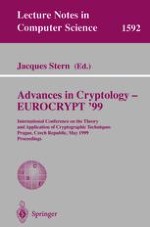1999 | Buch
Advances in Cryptology — EUROCRYPT ’99
International Conference on the Theory and Application of Cryptographic Techniques Prague, Czech Republic, May 2–6, 1999 Proceedings
herausgegeben von: Jacques Stern
Verlag: Springer Berlin Heidelberg
Buchreihe : Lecture Notes in Computer Science
Enthalten in: Professional Book Archive
